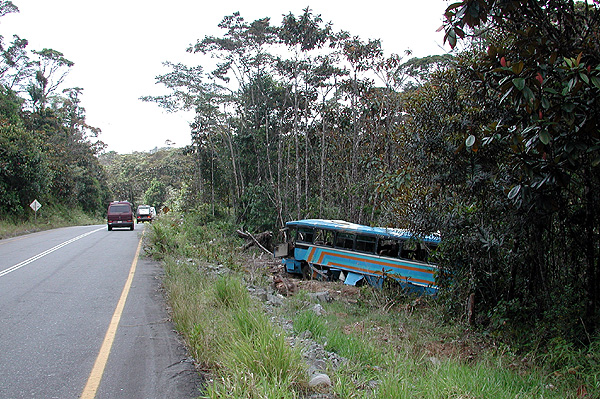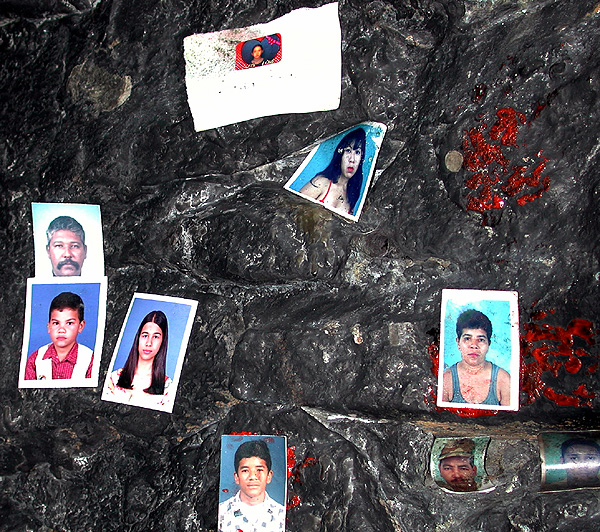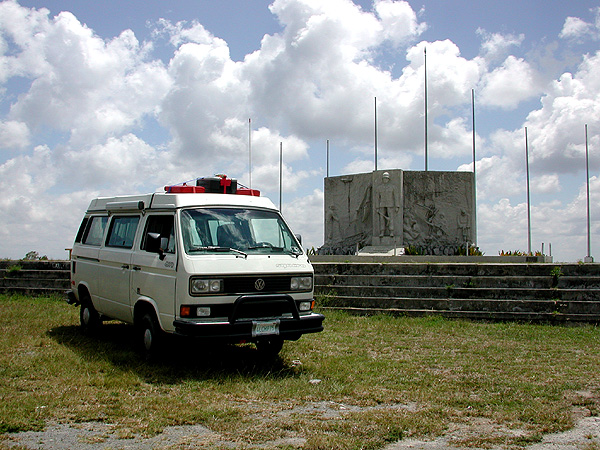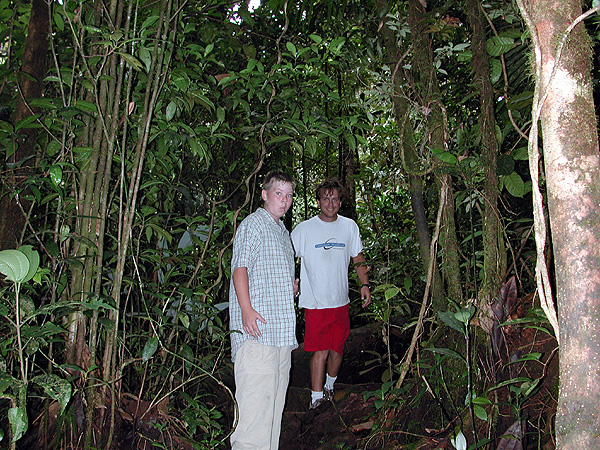This morning I had a conversation with the lady who owns La Montañita, the camp we stayed at last night. She has been running the camp alone since her husband, Oscar, died last October. She has four children, and the older ones go to school every day. Her two younger children are 1 and 2 years old. Unfortunately the camp has declined since Oscar’s passing… the water pump died and has not been fixed, and the landscaping has not been kept up. Nevertheless, the camp was still a pleasant place to stay the night, and her face brightened when I told her so.
Her two-year-old was sick, and she asked if we could give her a ride to Las Claritas, a mining town at Km 85. Of course we agreed, and the two of them and one of the daughters climbed into my van.
Along the way south she told me about how colonies of natives from British Guyana had setted in the area, and as a consequence, there were small pueblos along the way south where everyone spoke English. This stunned me a little, and I wanted to stop just to talk with people. English! Natives who spoke English! People with which I could exchange complex and witty thoughts! My mind was racing with the possibilities for communication, but I downshifted back into Spanish and drove on.
Las Claritas looked like the sort of somewhat dangerous Mexican town where you would find a bar full of hungry vampires. People stood in the street and glared at us as we slowly weaved around them. Guys doing business at the hardware store or eating a late breakfast at a roadside café would track our caravan with their eyes, wondering what new sort of
trouble we were. They probably thought we were coming to town to jump their claims.
Las Claritas is a gold-mining town. The entire area south from Ciudad Guyana to the Gran Sabana is riddled with gold and gold miners. In the 1880s there was a huge gold rush in this area, and many British companies came seeking their fortunes. At the same time, the British government claimed portions of Venezuela adjacent to British Guyana. In 1890 the Venezuelan Boundary Commission found historical precedent for the claim, and ruled that the territory was part of Guyana.
Venezuela wasn’t very pleased with the ruling. All maps printed since 1890 have a large section marked ‘Zona en Reclamacion’. The folks who live in this zone are citizens of Guyana, but are also considered Venezuelanos. Some of them use this de facto dual citizenship to move freely into Venezuela to work at the mines along Highway 10.
From Las Claritas we drove south to San Isidro, more frequently called simply Km 88. The town is a road stop, and is fairly dirty and expensive. Despite this, we ate an excellent desayuno criollo (‘creole breakfast’) there. It consisted of really delicious arepas and wonderful eggs scrambled with onions, peppers, and tomatoes. I also had a glass of jugo de melon (‘melon juice’), essentially fresh cantaloupe meat blended into a delicious juice. It was served ice cold. This is the way to eat cantaloupe.
While filling up with gas (‘sin plomo’, or unleaded), I was approached by a gentleman seeking a ride for his daughter to Santa Elena. She was carrying a backpack shaped like a teddy bear and a pillow case filled with her possessions… I agreed right away. She was travelling from her college in Maracay (between Valencia and Caracas) to visit her sick mother. We spoke for a while in Spanish, and then we both went quiet, each enjoying the changing scenery around us.
We headed south, and the road started climbing almost immediately. It wiggled and writhed through the jungle like so many things do, and we slowly made our way upwards.

We passed a bus which had gone off of the road. It had apparently not made the turn, and had slid down an embankment and into the jungle. The skid had not grown over, so the accident was fairly recent… probably less than a month. We all slowed down for a while.
A short distance up the road at Km 98.5, we came across the Piedra de la Virgin (‘Rock of the Virgin’), a huge gray stone with black streaks. We stopped and I said a prayer for my mother at the shrine containing a statue of the Virgin Mary and numerous lit candles. Tucked the alcove containing the statue of the virgin were many, many photographs. Some were of babies, some of children, and some photos were of adults. I hoped that the prayers of and for these people had been answered, but the cynical, post-Catholic side of me knew that many had not. I felt like Sidhartha, seeing for the first time all of the suffering of the world.

There was a stream coming down from the mountain by the shrine. I cupped water in my hands and splashed it against my face. It felt good. I scooped up more and let it run through my hair and down the back of my neck.
At Km 135 we reached the top of our climb and looked out over the Gran Sabana (‘Grand Savanah’). This is one of the oldest plateaus on the planet. Most of the Gran Sabana is at an altitude of around 4500 feet, and the air is cool and refreshing. The landscape is rolling, crossed by rivers and many, many waterfalls. It’s a beautiful area, and Venezuela has had the foresight to make most of it part of Parque Nacional Canaima, at 3,000,000 hectares, one of the largest parks on earth. (We were also in this park when we visited Salto Angel.)

We stopped at a monument to the Soldado Pionero (Soldier Pioneer) who originally built the road up to the Gran Sabana in 1973. We stood there for a while simply breathing. I liked the jungle quite a bit, but given a choice, I prefer a cold climate. This air reminded me of the night
breezes in San Francisco. Bracing, cool, and clean.
We stopped at Salto Danto at Km 119, and walked down a slippery slope and through the jungle to the base of the falls. We stopped again at Km 200 to visit another falls, where a bus had stopped for a rest and the passengers were swimming in the pool at the base of the falls. A couple of teenagers took turns posing like models in front of the falls while old men lounged in the shallows.

Tonight we’re in Santa Elena. We’ve checked into a hotel and we’re having our laundry done. I filled a sink up with Permethrin solution and we soaked all of our mosquito netting in preparation for the malarial journey ahead. (Permethrin bothers the heck out of mosquitos
and ticks and is only one stage of our Maginot line.)
Tonight we went to a local hot spot for dinner. The restaurant / bar / pool hall was obviously filled with miners with a paycheck to spend. Two waitresses worked the tables, each posessing an ass of biblical proportions. They were goddesses bring beer to the mortals. Jeanne was convinced that most of the other women in the bar / restaurant / pool hall were whores. If they were, then they were the oldest, ugliest whores I’ve ever seen. The whore who attacked me in Paris1A story to be told another day. was Aphrodite by comparison.
These women were, however, dressed in short, tight spandex miniskirts and shirts with necklines plunging south of their navels, so perhaps Jeanne is right. This is, however, something that I prefer not to think about any longer.
A band started playing at a volume somewhere between an Apollo launch and a nuclear incident. Folks got up and danced the two-step. Others, both inside the restaurant and standing out in the street, watched through the open front of the restaurant. We finished our dinner and left… the music was good, but the volume was unbearable. Behind us, couples danced down the middle of the street.
Ron
- 1A story to be told another day.